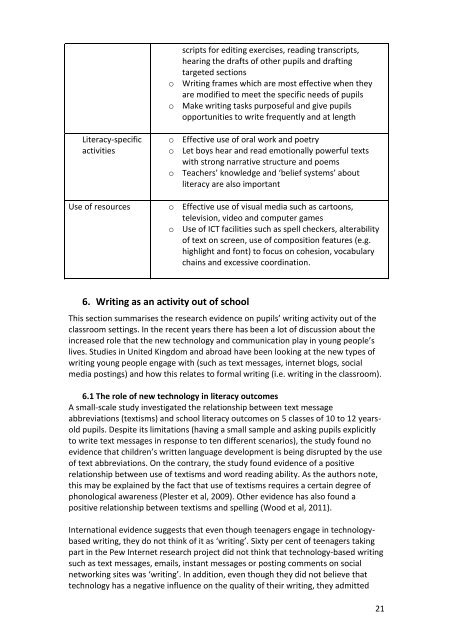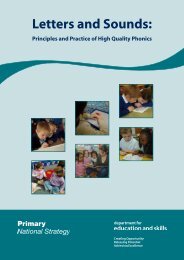What is the research evidence on writing? - Department for Education
What is the research evidence on writing? - Department for Education
What is the research evidence on writing? - Department for Education
You also want an ePaper? Increase the reach of your titles
YUMPU automatically turns print PDFs into web optimized ePapers that Google loves.
Literacy-specific<br />
activities<br />
Use of resources<br />
6. Writing as an activity out of school<br />
scripts <strong>for</strong> editing exerc<str<strong>on</strong>g>is</str<strong>on</strong>g>es, reading transcripts,<br />
hearing <str<strong>on</strong>g>the</str<strong>on</strong>g> drafts of o<str<strong>on</strong>g>the</str<strong>on</strong>g>r pupils and drafting<br />
targeted secti<strong>on</strong>s<br />
o Writing frames which are most effective when <str<strong>on</strong>g>the</str<strong>on</strong>g>y<br />
are modified to meet <str<strong>on</strong>g>the</str<strong>on</strong>g> specific needs of pupils<br />
o Make <strong>writing</strong> tasks purposeful and give pupils<br />
opportunities to write frequently and at length<br />
o Effective use of oral work and poetry<br />
o Let boys hear and read emoti<strong>on</strong>ally powerful texts<br />
with str<strong>on</strong>g narrative structure and poems<br />
o Teachers’ knowledge and ‘belief systems’ about<br />
literacy are also important<br />
o Effective use of v<str<strong>on</strong>g>is</str<strong>on</strong>g>ual media such as carto<strong>on</strong>s,<br />
telev<str<strong>on</strong>g>is</str<strong>on</strong>g>i<strong>on</strong>, video and computer games<br />
o Use of ICT facilities such as spell checkers, alterability<br />
of text <strong>on</strong> screen, use of compositi<strong>on</strong> features (e.g.<br />
highlight and f<strong>on</strong>t) to focus <strong>on</strong> cohesi<strong>on</strong>, vocabulary<br />
chains and excessive coordinati<strong>on</strong>.<br />
Th<str<strong>on</strong>g>is</str<strong>on</strong>g> secti<strong>on</strong> summar<str<strong>on</strong>g>is</str<strong>on</strong>g>es <str<strong>on</strong>g>the</str<strong>on</strong>g> <str<strong>on</strong>g>research</str<strong>on</strong>g> <str<strong>on</strong>g>evidence</str<strong>on</strong>g> <strong>on</strong> pupils’ <strong>writing</strong> activity out of <str<strong>on</strong>g>the</str<strong>on</strong>g><br />
classroom settings. In <str<strong>on</strong>g>the</str<strong>on</strong>g> recent years <str<strong>on</strong>g>the</str<strong>on</strong>g>re has been a lot of d<str<strong>on</strong>g>is</str<strong>on</strong>g>cussi<strong>on</strong> about <str<strong>on</strong>g>the</str<strong>on</strong>g><br />
increased role that <str<strong>on</strong>g>the</str<strong>on</strong>g> new technology and communicati<strong>on</strong> play in young people’s<br />
lives. Studies in United Kingdom and abroad have been looking at <str<strong>on</strong>g>the</str<strong>on</strong>g> new types of<br />
<strong>writing</strong> young people engage with (such as text messages, internet blogs, social<br />
media postings) and how th<str<strong>on</strong>g>is</str<strong>on</strong>g> relates to <strong>for</strong>mal <strong>writing</strong> (i.e. <strong>writing</strong> in <str<strong>on</strong>g>the</str<strong>on</strong>g> classroom).<br />
6.1 The role of new technology in literacy outcomes<br />
A small-scale study investigated <str<strong>on</strong>g>the</str<strong>on</strong>g> relati<strong>on</strong>ship between text message<br />
abbreviati<strong>on</strong>s (text<str<strong>on</strong>g>is</str<strong>on</strong>g>ms) and school literacy outcomes <strong>on</strong> 5 classes of 10 to 12 yearsold<br />
pupils. Despite its limitati<strong>on</strong>s (having a small sample and asking pupils explicitly<br />
to write text messages in resp<strong>on</strong>se to ten different scenarios), <str<strong>on</strong>g>the</str<strong>on</strong>g> study found no<br />
<str<strong>on</strong>g>evidence</str<strong>on</strong>g> that children’s written language development <str<strong>on</strong>g>is</str<strong>on</strong>g> being d<str<strong>on</strong>g>is</str<strong>on</strong>g>rupted by <str<strong>on</strong>g>the</str<strong>on</strong>g> use<br />
of text abbreviati<strong>on</strong>s. On <str<strong>on</strong>g>the</str<strong>on</strong>g> c<strong>on</strong>trary, <str<strong>on</strong>g>the</str<strong>on</strong>g> study found <str<strong>on</strong>g>evidence</str<strong>on</strong>g> of a positive<br />
relati<strong>on</strong>ship between use of text<str<strong>on</strong>g>is</str<strong>on</strong>g>ms and word reading ability. As <str<strong>on</strong>g>the</str<strong>on</strong>g> authors note,<br />
th<str<strong>on</strong>g>is</str<strong>on</strong>g> may be explained by <str<strong>on</strong>g>the</str<strong>on</strong>g> fact that use of text<str<strong>on</strong>g>is</str<strong>on</strong>g>ms requires a certain degree of<br />
ph<strong>on</strong>ological awareness (Plester et al, 2009). O<str<strong>on</strong>g>the</str<strong>on</strong>g>r <str<strong>on</strong>g>evidence</str<strong>on</strong>g> has also found a<br />
positive relati<strong>on</strong>ship between text<str<strong>on</strong>g>is</str<strong>on</strong>g>ms and spelling (Wood et al, 2011).<br />
Internati<strong>on</strong>al <str<strong>on</strong>g>evidence</str<strong>on</strong>g> suggests that even though teenagers engage in technologybased<br />
<strong>writing</strong>, <str<strong>on</strong>g>the</str<strong>on</strong>g>y do not think of it as ‘<strong>writing</strong>’. Sixty per cent of teenagers taking<br />
part in <str<strong>on</strong>g>the</str<strong>on</strong>g> Pew Internet <str<strong>on</strong>g>research</str<strong>on</strong>g> project did not think that technology-based <strong>writing</strong><br />
such as text messages, emails, instant messages or posting comments <strong>on</strong> social<br />
networking sites was ‘<strong>writing</strong>’. In additi<strong>on</strong>, even though <str<strong>on</strong>g>the</str<strong>on</strong>g>y did not believe that<br />
technology has a negative influence <strong>on</strong> <str<strong>on</strong>g>the</str<strong>on</strong>g> quality of <str<strong>on</strong>g>the</str<strong>on</strong>g>ir <strong>writing</strong>, <str<strong>on</strong>g>the</str<strong>on</strong>g>y admitted<br />
21
















